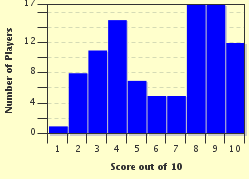Quiz Answer Key and Fun Facts
1. 1967 was "The Summer of Love" and "flower power" was at its zenith. There were a few charting songs that exemplified the movement and one of them soared up to Number Two on the Billboard Hot 100. Two weeks in that position, it couldn't nudge its way past "Daydream Believer" by The Monkees. Here's a fair portion of the first stanza for a clue. What hit was it?
"She could make me very happy
Flowers in her hair ... flowers everywhere... everywhere
I love the flower girl
Oh I don't know just why; she simply caught my eye
I love the flower girl
She seemed so sweet and kind, she crept into my mind"
2. "I'll make you happy, baby, just wait and see
For ev'ry kiss you give me, I'll give you three
Oh, since the day I saw you
I have been waiting for you
You know I will adore you 'til eternity"
This was the second of two verses from a hit consigned to Number Two for three weeks on the Hot 100 in 1963 due to the popularity of "Sugar Shack" by Jimmy Gilmer and The Fireballs. Performed by one of the ubiquitous "girl groups" that were springing up at the time, it was their biggest hit by far. Can you identify it?
3. A Number Two Billboard hit from 1966 was composed by Paul Simon but never released by him, neither as a solo act nor with his longtime associate, Art Garfunkel. Name the song that features this lyric segment, the final stanza, recorded by a group that rolled downhill with each successive single they released thereafter, right to oblivion.
"The story's in the past with nothin' to recall
I've got my life to live and I don't need you at all
The roller-coaster ride we took is nearly at an end
I bought my ticket with my tears, that's all I'm gonna spend"
4. When The Beatles owned the top rung of the Hot 100 in early 1964, a number of fine songs had to be content being Number Two in the pecking order. Such was the case for this hit. Stymied for three weeks by "I Want To Hold Your Hand", try to figure out what song it was from this slice of lyric.
"I'm young and I love to be young
I'm free and I love to be free
To live my life the way I want
To say and do whatever I please"
5. In December 1968, "I Heard It Through The Grapevine" by Marvin Gaye commenced a seven week run atop the Hot 100. For two of those weeks, a fellow Tamla recording act lingered at Number Two with a song featuring these lines.
"This is mine, you can't take it
Long as I know I've got love, I can make it"
What song was this?
6. A New Orleans singer and contemporary of Fats Domino had only one big hit and it spent three weeks at Number Two in 1961. Only the biggest hit of that year, "Tossin' And Turnin" by Bobby Lewis, prevented it from reaching Number One. The song's two verses weren't very memorable but the chorus line was. It went "Come on, come on let me show you where it's at". My question to you is "Where was it at"?
7. "Ah, each time I see you, baby my heart cries
I tell ya, I'm gonna steal you away from all those guys
Whoa, oh, oh, oh, oh, from the happy day I met ya
Now I made a bet that I was goin' to get ya"
This lyrical segment comes from a rocking little Number Two song from 1963. The girl's name is in the title. The trouble is, which one?
8. We're going to play a little game of matching the instrumental hit with the artist that recorded it. I'll list three artists and below you'll be given four hits for options. If you successfully match up those three artists with their instrumental hits, you'll have one title left over... the correct answer to a 1960s Number Two hit. Here are your choices for the artist: The Mar-Keys, Mason Williams and Hugh Masekela.
9. One of the bigger hits of 1969 was "In The Year 2525" by Zager and Evans. While it ruled the Hot 100 for six weeks, another pleasant, quasi-psychedelic song with religious overtones cooled its heels for three weeks at Number Two. Here's the first stanza for lyrical assistance.
"Look over yonder what do you see
The sun is a-risin' most definitely
A new day is comin', people are changin'
Ain't it beautiful"
10. A group that broke onto the musical scene in 1967 with a Number One Billboard hit returned to the chart in a big way with their second biggest hit, a Number Two, in 1968. Let's see if you can recognize it from this sequence of the lyric.
"I know now that you're not a play thing
Not a toy or a puppet on a string
Today we passed on the street and you just walked on by
My heart just fell to my feet and once again I began to cry"
Source: Author
maddogrick16
This quiz was reviewed by FunTrivia editor
kyleisalive before going online.
Any errors found in FunTrivia content are routinely corrected through our feedback system.

